New Features
- .NET Core 2.1 SDK support
- .NET Core 2.1 SDK project templates
- HTTPS development certificate support
- .NET Core global tools added to PATH on startup
- .NET Core location can now be configured
- Xamarin.Forms project templates now use .NET Standard projects
- Performance improvements when using projects with many files
- .NET Core templating engine has been updated
- Improved support for Xamarin.Forms
- Item templates are now supported with the .NET Core templating engine
More information on all the new features and changes in Visual Studio for Mac 7.5 can be found in the release notes.
.NET Core 2.1 SDK support
Visual Studio for Mac 7.5 includes support for the .NET Core 2.1 SDK which is currently available as a release candidate. The following sections will look into the support provided by Visual Studio for Mac 7.5 for the .NET Core 2.1 SDK.
.NET Core 2.1 SDK project templates
If .NET Core 2.1.300 SDK is installed then the .NET Core 2.1 project templates will be available in the New Project dialog.
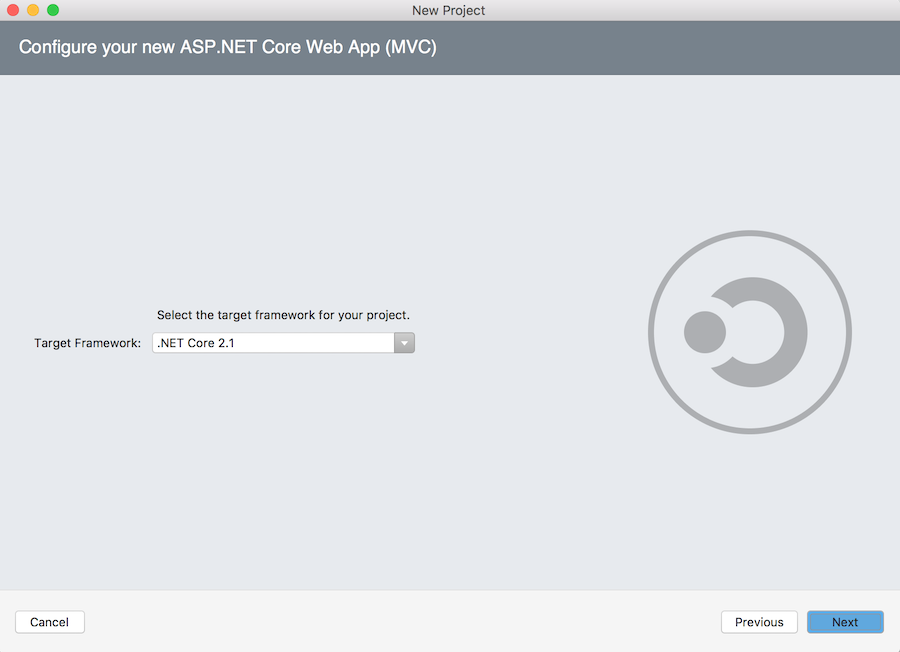
The .NET Core 2.1 project templates are not included with Visual Studio for Mac and will be searched for in the 2.1.300 SDK templates directory.
/usr/local/share/dotnet/sdk/2.1.300-rc1-008673/Templates/
The project templates for .NET Core 2.0 and 1.1 are currently still being shipped with Visual Studio for Mac.
HTTPS development certificate support
ASP.NET Core 2.1 projects use HTTPS by default. In order to be able to run ASP.NET Core 2.1 projects with HTTPS a development certificate needs to be installed. Visual Studio for Mac will detect if the development certificate is missing and offer to install it when you run an ASP.NET Core 2.1 project that uses HTTPS.

Visual Studio for Mac will use the dotnet dev-certs tool to check if the HTTPS development certificate is installed and trusted.
dotnet dev-certs https --trust --check
Installing the HTTPS certificate requires administrator privileges so you may be prompted for your username and password after clicking the Yes button. Currently the prompt for credentials shows mono-sgen64 wants to make changes. In the future this will show a custom message indicating that the credentials are required to install the HTTPS development certificate.
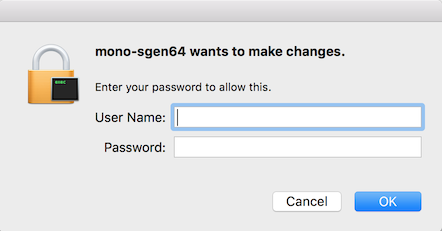
After entering your credentials the following command is run as administrator.
dotnet dev-certs https --trust
After the certificate is installed the ASP.NET Core 2.1 project will be opened in the default browser using HTTPS.
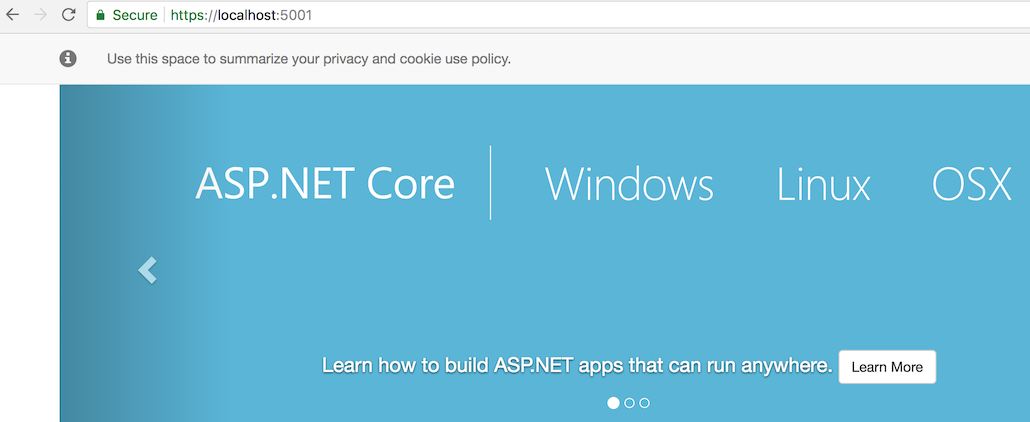
Running dotnet dev-certs https —trust to install and trust the certificate needs to be done with administrator privileges with the user id 0. To do this Visual Studio for Mac does the following:
- Launches a separate custom console app.
- The console app uses the AuthorizationExecuteWithPrivileges Mac API provided by Xamarin.Mac to launch itself as again as administrator. It is not possible to run dotnet as administrator initially since it requires the user id to be set to 0, which is what happens when you use sudo dotnet, and this can only be done when running with administrator privileges. So the console app is launched again but this time with administrator privileges.
- The console app, now being run with administrator privileges, will use setuid to set the current user id to 0.
- The console app then runs dotnet dev-certs https —trust which will install and trust the HTTPS development certificate.
The dotnet dev-certs https —trust command will add two localhost certificates. You can see these by opening the Keychain Access application and searching for localhost.
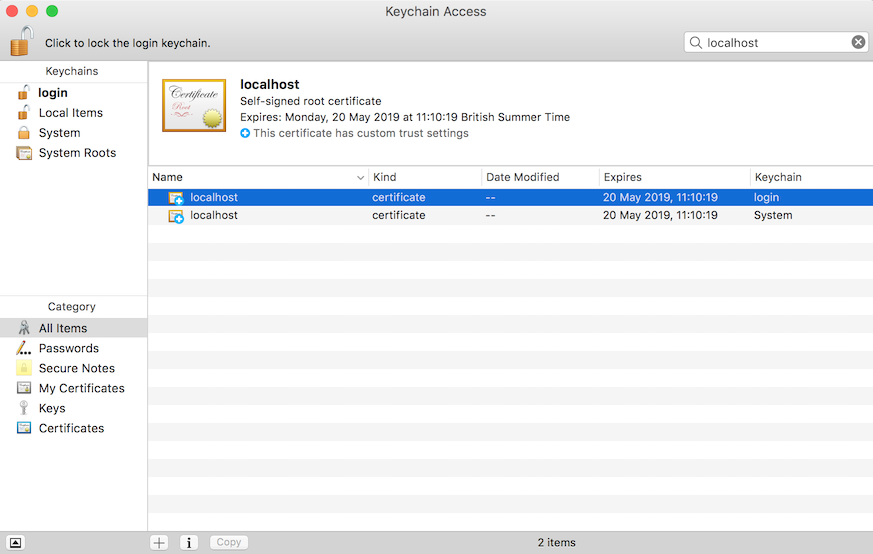
If the HTTPS development certificate is found to be valid and trusted then this will be remembered for the current Visual Studio for Mac session and a check will not be run again during the current session.
.NET Core global tools added to path on startup
The .NET Core SDK 2.1 supports installing global tools. These tools are .NET Core console apps that are available as NuGet packages and can be installed and used from the command line. To be able to use these tools with the dotnet command line the ~/.dotnet/tools directory needs to be added to the PATH environment variable. The path to these global tools is now added to Visual Studio’s PATH environment variable when it starts.
Prompt to install .NET Core 2.1 SDK if not installed
If a .NET Core 2.1 project is opened and .NET Core 2.1.300 SDK is not installed then a dialog will be shown allowing the SDK to be downloaded. The project in the Solution window will show an error icon indicating that the .NET Core 2.1 SDK is not installed.
Launching a browser when running an ASP.NET Core 2.1 project
The .NET Core SDK 2.1 project templates for ASP.NET Core specify the https and http urls in the launchSettings.json file by using the applicationUrl property.
"MyAspNetCore21Project": {
"commandName": "Project",
"launchBrowser": true,
"applicationUrl": "https://localhost:5001;http://localhost:5000",
"environmentVariables": {
"ASPNETCORE_ENVIRONMENT": "Development"
}
}
With earlier .NET Core 2.1 preview SDKs this was defined in the ASPNETCORE_URLS environment variable. The full applicationUrl property was used unmodified when running the ASP.NET Core 2.1 project and resulted in an invalid url being used causing the AspNetCoreExecutionHandler to log a warning and not opening the browser. Now the first url in the applicationUrl is used if there are multiple urls.
Support ASPNETCORE_URLS when launching the browser
If the launchSettings.json does not define an applicationUrl then Visual Studio for Mac will fallback to checking the environment variable defined for ASPNETCORE_URLS in the launchSettings.json file and will use the first url found there. This url will be used to launch the browser when running the project.
An example launchSettings.json that was used in the .NET Core 2.1 preview SDKs is shown below.
"MyProject": {
"commandName": "Project",
"launchBrowser": true,
"environmentVariables": {
"ASPNETCORE_ENVIRONMENT": "Development",
"ASPNETCORE_URLS": "https://localhost:5001;http://localhost:5000"
}
}
Compared with the .NET Core SDK 2.0.
"MyProject": {
"commandName": "Project",
"launchBrowser": true,
"environmentVariables": {
"ASPNETCORE_ENVIRONMENT": "Development"
},
"applicationUrl": "http://localhost:5000/"
}
Allow .NET Core location to be configured
In Preferences there is now a Projects – SDK Locations – .NET Core section that can be used to configure the location of the .NET Core command line tool (dotnet).
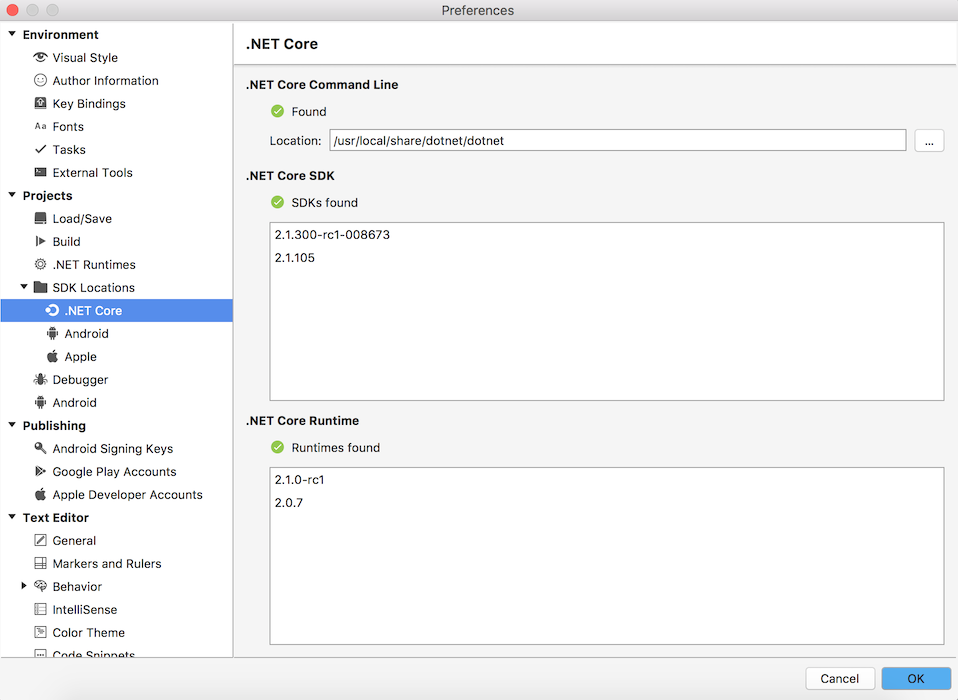
This can be used to configure Visual Studio for Mac to use a .NET Core SDK that is not installed in the default location. After this is changed the MSBuild engine hosts are recycled and all .NET Core projects are re-evaluated to ensure the new locations of any MSBuild targets are used.
If the location is invalid, or no runtimes or SDKs can be found at the configured location, a Not found error will be displayed.
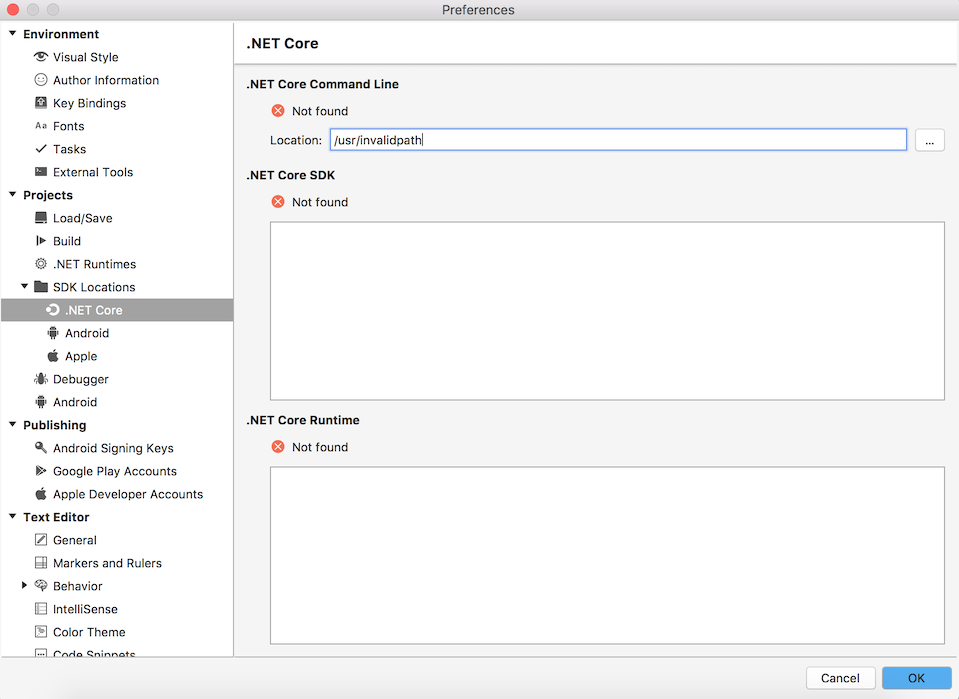
Xamarin.Forms Project Templates now include .NET Standard projects
The Xamarin.Forms project templates, Blank Forms App and Forms App, will now create a .NET Standard 2.0 project instead of a Portable Class Library (PCL) project if .NET Standard is selected in the New Project dialog.
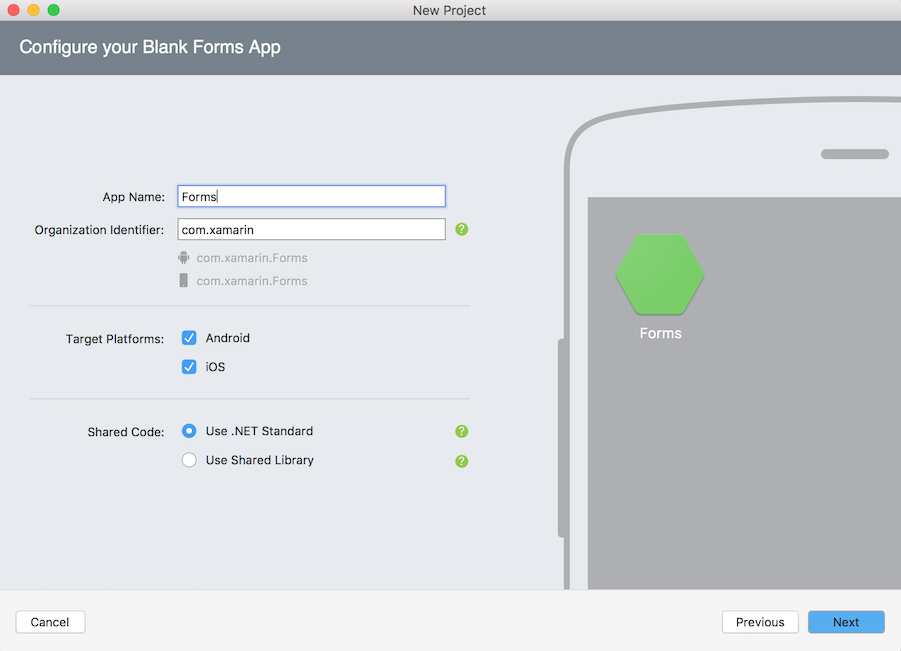
The Xamarin.Forms Class Library project template now creates a .NET Standard 2.0 project instead of a Portable Class Library project.
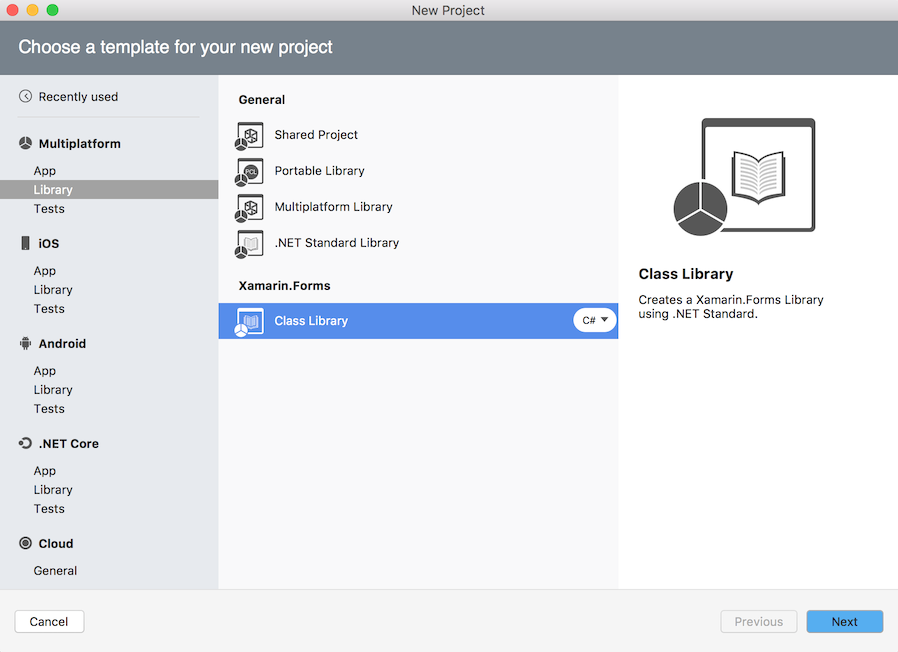
Prevent .xaml.cs file from being renamed in a .NET Core project
The Xamarin.Forms NuGet package has an MSBuild .targets file that is imported after the project items are defined. This .targets file overrides the DependentUpon property for all .xaml.cs files. This means that renaming the .xaml.cs file to be different to the .xaml file is not supported. To prevent this the Rename menu is now disabled in the Solution window for .xaml.cs files if they depend on a .xaml file.
Exclude None build action for XAML files in .NET Core projects
Recent versions of Xamarin.Forms NuGet packages exclude all .xaml files from the default None file wildcard defined by the .NET Core SDK. This exclusion is done in a .targets file which is applied after the items in the project file have been added. This means that a .NET Standard project should not use None items for .xaml files since they will be removed. To avoid this problem the None build action is excluded from the list of build actions for .xaml files. This list of build actions is available when right clicking the file in the Solution window and in the Properties window when the file is selected.
Dependent files now renamed on renaming parent file in the Solution window
When a file is renamed in the Solution window the dependent files will also be renamed if they start with the same name as the parent file. This avoids problems with XAML files since a different name for the .xaml file and the associated .xaml.cs file is not supported.
Improve project load times for projects with many files
Opening a .NET Core project that contained many files that were not excluded, such as a .NET Core console project that has a node_modules directory, could take a long time to load.
Some performance improvements have been made to speed up the loading of .NET Core projects. For a .NET Core console project that had a node_modules directory containing around 17000 files the initial project load time which was taking around 70-80 seconds and now it takes around 20 seconds. Visual Studio 2017 on Windows takes around 15-20 seconds to load the same project before it is visible in the Solution Explorer window.
The performance improvements include:
- Adding a faster project item lookup used when finding an existing project item on loading the project.
- Updating the existing project items is now faster avoiding iterating over the existing items.
- Evaluating MSBuild items is now only done when evaluating properties. Previously this was done when evaluating project configurations and run configurations. This would result in files and directories being searched multiple times when looking wildcard matches on loading the project. Now the files and directories are searched once during the initial project load.
.NET Core templating engine updated
Updated the .NET Core templating to version 1.0.0-beta3-20171117-314. This new version of the .NET Core templating engine fixes the following problems:
- Templates that use files with @ character in their names being generated with the @ symbol encoded.
- Templates that use the Guid macro and did not specify a format would cause the template generation to fail. An exception was thrown since the format was not defined. Now if the format is not defined the default format is used.
Report template creation failures when using the .NET Core templating engine
To help diagnose problems with project and item templates that use the .NET Core templating engine more detailed information about the failure is now logged in the IDE log.
Support item templates with the new templating engine
Item templates that use the .NET Core templating engine can be defined through a new extension point.
<Extension path="/MonoDevelop/Ide/ItemTemplates">
<Template
id="Azure.Function.CSharp.BlobTrigger"
_overrideName="Blob Trigger"
path="Templates/Azure.Functions.Templates.nupkg" />
</Extension>
Item templates are not currently supported in the New File dialog however there is an API that can be used by extensions to create files from these templates. This is currently used when adding a new Azure Function to a project.
Bug Fixes
Missing child package dependencies in Solution window
After creating a new ASP.NET Core project sometimes the package dependencies shown in the Solution window under the SDK folder and the NuGet folder could not be expanded to view the child dependencies.
The problem was that if the call to get the package dependencies using MSBuild was cancelled this would result an empty list of depenencies being cached. Since no package dependencies were returned the Solution window would fallback to showing the package dependencies that were listed in the project and a default top level SDK package dependency.
MSBuild wildcards being expanded on saving a project
Saving a project with a file wildcard that had a Link with MSBuild item metadata, as shown below, would result in the wildcard being removed and replaced with MSBuild items for each file included by the wildcard.
<Compile Include="**\*.cs" Exclude="obj\**">
<Link>%(RecursiveDir)%(Filename).cs</Link>
</Compile>
The problem was that the evaluated Link property value was being compared with the unevaluated value, which did not match, resulting in the wildcard being replaced with individual MSBuild items for each file. Now if the property value contains a % character a comparison is made against the evaluated value when checking if the project item has changed.
MSBuild items added for wildcards with link metadata on saving project
A project containing the following MSBuild file wildcards would have extra MSBuild items added when the project file was saved.
<ItemGroup>
<Compile Include="..\**\*.cs">
<Link>%(RecursiveDir)%(Filename)%(Extension)</Link>
</Compile>
</ItemGroup>
On saving the project Compile update items would be added for each file included by the file wildcard.
<ItemGroup>
<Compile Update="..\Test\Class1.cs">
<Link>Class1.cs</Link>
</Compile>
</ItemGroup>
This problem is similar to the previous problem where the evaluated Link value was being compared with the unevaluated value, which did not match, resulting MSBuild update items being added to the project when it was saved. Now if the property value contains a % character a comparison is made against the evaluated value when checking if the project item has changed.
TargetFramework changed on saving project
Adding a file to an SDK style project that targeted Tizen 4.0 would result in the TargetFramework changing from tizen40 to tizen4.0. Now the original framework identifier name is not modified and if the version of the framework changes then the version will be dotted or contain only numbers based on the format that was originally used in the project file.
ASP.NET Core file templates modifying project file
Adding a new .cshtml file from a file template to an ASP.NET Core project would modify the project file when it should not have been modified. The problem was the files were added as None items whilst .cshtml are Content items. The project file would contain the following after adding a new cshtml file from a template:
<ItemGroup>
<Content Remove="Views\Index.cshtml" />
</ItemGroup>
<ItemGroup>
<None Include="Views\Index.cshtml" />
</ItemGroup>
Another problem was that the Razor Page with view model file template specifies a DependentUpon property so this was added to the project file. This would result in the .cshtml and .cs files being nested whilst the other .cshtml and .cs files created with the initial ASP.NET Core project template were not nested. The project file would include the following:
<ItemGroup>
<Compile Update="Views\Index.cshtml.cs">
<DependentUpon>Index.cshtml</DependentUpon>
</Compile>
</ItemGroup>
The .NET Core SDK does not indicate that .cshtml and .cs files are dependent on each other so they are not currently nested in the Solution window. New .cshtml files created from these updated file templates will now not be nested in Solution window.
XAML files not nested after editing project file in editor
Adding a new content page with xaml to a .NET Standard project, then excluding the files from the project, but not deleting it, then editing the project file and commenting out the MSBuild remove items, would then result in the xaml files not being nested in the Solution window. The problem was that the MSBuild update item for the .xaml.cs file, defined by the Xamarin.Forms default msbuild items, was being removed from the MSBuild project in memory. This MSBuild update item had the DependsOn property defined so this information was lost on reloading the project. Now a check is to made to ensure only update items that exist in the original project file are removed.
MSBuild item added for XAML file copied to a .NET Standard project
When copying a .xaml file from a Portable Class Library project to a .NET Standard project an MSBuild include item for the file would be added if the .xaml file did not have the default metadata properties defined by Xamarin.Forms. Now .NET Core projects opt-in to supporting items not being excluded if they are missing MSBuild item metadata which prevents an MSBuild include item added for the .xaml file.
Duplicate XAML file build error when copying file to a .NET Standard project
Copying a .xaml file from a Portable Class Library project to a .NET Standard project would result an MSBuild item for the .xaml file to the project causing it to not build due to a duplicate .xaml file.
Now when a xaml file is copied into a .NET Standard project, and it is missing properties that are included in by an update wildcard, an MSBuild item will not be added to the project.
MSBuild remove item not added for .xaml.cs file
With a .NET Core project, containing a single .xaml file and a dependent .xaml.cs file, removing but not deleting the .xaml file from the Solution window would not add an MSBuild remove item for the .xaml.cs file even though it was removed from the Solution window.
The problem was that the Xamarin.Forms NuGet package includes a Compile update item and only this was being considered when saving the project file. The default file wildcard, that includes all .cs files, provided by the .NET Core SDK was not considered. Only the last MSBuild item associated with the .xaml.cs file was being considered. If there was another .cs file in the project then the MSBuild remove item was added correctly. To avoid this all MSBuild items associated with a project item are now considered.
MSBuild remove item not removed on adding XAML file to project
When an .xaml file was removed but not deleted, and Xamarin.Forms 2.5 used, which has default MSBuild items defined, on adding the .xaml file back again to the project the EmbeddedResource remove item was not removed from the project.
The problem was that the .xaml file was being added as a None item since by default there is no build action specified for .xaml files.
Another problem was that the MSBuild remove items, defined by Xamarin.Forms that remove all .xaml files from the default None included by the .NET Core SDK, were being ignored since the file wildcards were not found.
Also an msbuild item is no longer added for an existing xaml file when it is added to the project. The Xamarin.Forms default msbuild items for .xaml files have extra metadata which were not being added to the file when it was added to the project from the file system.
Update item added on renaming xaml.cs file
When the .xaml and .xaml.cs file were renamed at the same time an MSBuild update item was added for the .xaml.cs file even though the Xamarin Forms NuGet package has a default MSBuild item that was the same as the generated MSBuild update item.
Argument null exception logged on opening .NET Core project
Opening a .NET Core project would sometimes log an unhandled ArgumentNullException. A file created event was sometimes raised before the project had finished loading and could result in a null set of items being used when checking if the new file should be added to the project. This is now handled. The files being created on project load are typically in the obj folder and would be ignored by the default file wildcards.
An unhandled exception has occured. Terminating Visual Studio? False
System.ArgumentNullException: Value cannot be null.
Parameter name: source
at System.Linq.Enumerable.Where[TSource]
in corefx/src/System.Linq/src/System/Linq/Where.cs:42
at MonoDevelop.Projects.Project.OnFileCreatedExternally
in src/core/MonoDevelop.Core/MonoDevelop.Projects/Project.cs:4041